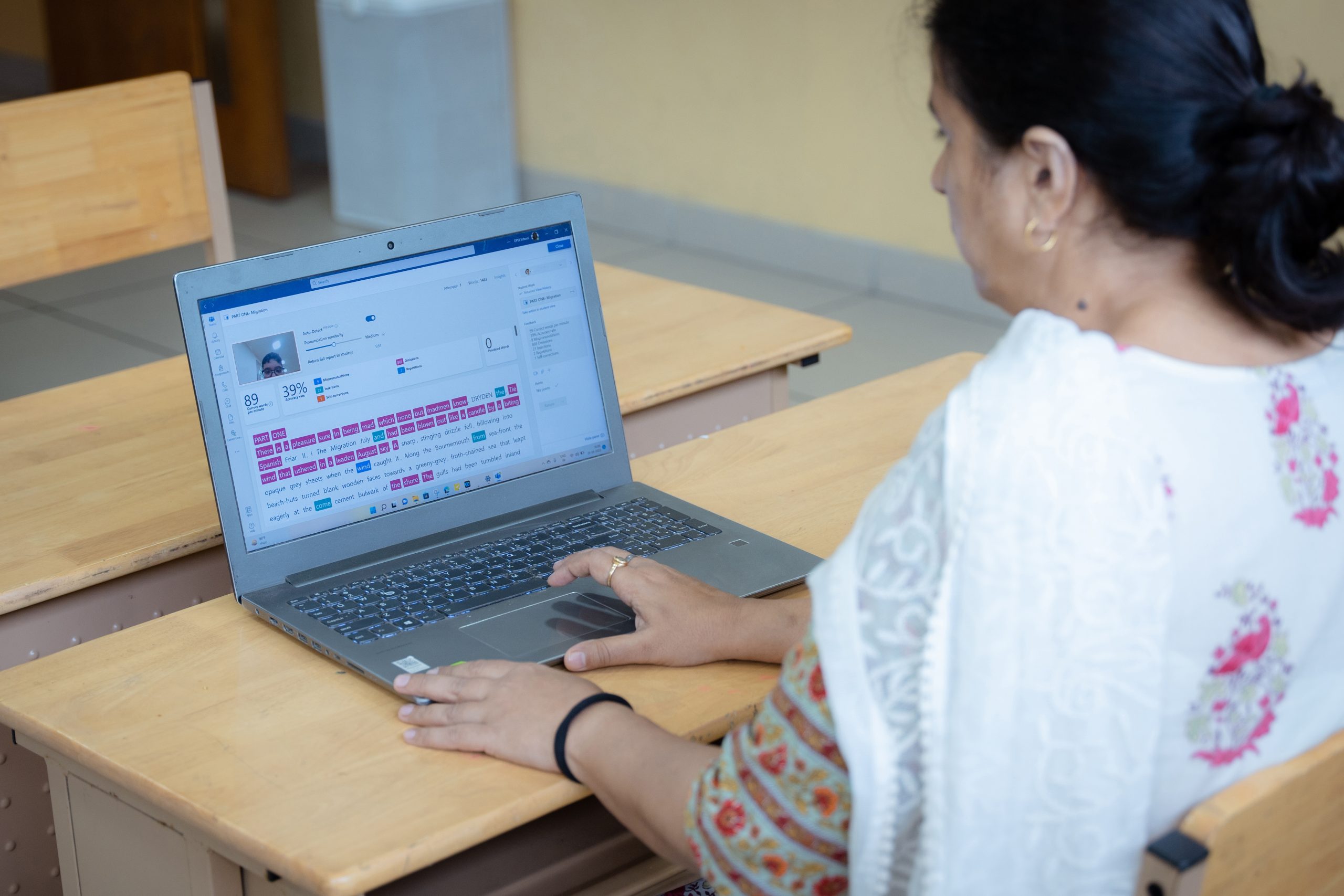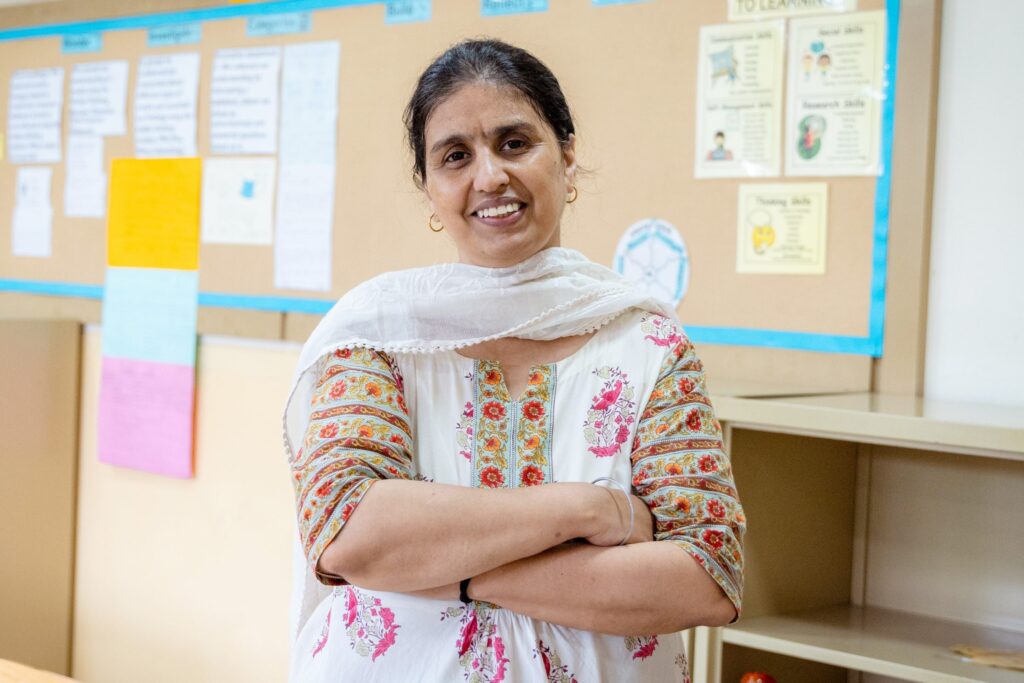Over her twenty-two-year career as an educator, Gunjan Tomar has witnessed the quantum leaps in her profession.
When she started her career, teachers used to stand in front of a blackboard, lecturing with a piece of chalk. Today, they customize their lessons and respond sensitively according to the needs of individual students.
“The education system has become so student-centric because technology made it possible,” Tomar said.
Tomar is a Services, Action, and Activities Coordinator at DPS International in Gurugram, a bustling city home to the headquarters of many MNCs near India’s capital city of New Delhi. Her role there is unique: she supports the learning of students with cognitive disabilities, who have different learning needs.
“I wish to make each child functionally independent,” she said. “This can be a challenge, since children with cognitive disabilities process information differently.”
She’s also a Microsoft Innovative Educator Expert (MIEE) and a Microsoft Certified Educator (MCE), a certification she applied for in 2015 after a Microsoft Education Partner mentioned how her work with digital upskilling was aligned with Microsoft’s own vision for technology-facilitated education in India.
“She told me that you’re doing so much with technology and Microsoft is also doing a lot of work in education. Go and explore what they have to offer,” Tomar recounted.
The Microsoft Innovative Educator program was a turning point in Tomar’s career.
The self-paced courses allowed her to lead her own professional development. She also gained a lively community to bounce off ideas. It sparked her curiosity and touched a chord with her own perspective about the purpose of education.
Her enthusiasm is palpable over a Microsoft Teams call. “What could I do to the best of my abilities so that my students can perform to the best of theirs?” Tomar said, “That is how my journey started, thinking about this.”
One of Tomar’s foundational takeaways from the MIE program was about multi-modality—the ability to merge text, video, and audio in a single lesson to address variability in how different students learn.
Tomar, ever the experimenter, wasted no time in taking new learnings to the classroom—but not before she tried them out herself first. “I first tried working with these tools myself. And you know, you just need a week or two to see if something works for students or not.”
One of her first successes was with OneNote. “I had a student whose chronological age should have been at Grade 7 level, but his cognitive ability was at the Grade 2 level,” she explained. The student was having trouble reading larger chunks of text.
She introduced him to OneNote’s Immersive Reader feature, which uses the TTS (Text-to-Speech) technology to read back paragraphs and breaks down complex words into simpler syllables. There was a marked improvement in the student’s comprehension skills after he started using this feature.

Her years as a teacher means that Tomar is particularly sensitive to students’ strengths, weaknesses, and perhaps most significantly, areas of interest. These perspectives are what help her marry the right technology solution with a student’s needs.
For students who struggle with mathematics, for instance, she may recommend the math tool in OneNote that not only solves equations but also shows the steps on how to arrive at the solution.
Her students’ parents testify to the impact. “Gunjan Ma’am is very supportive and compassionate towards my son,” says the mother of a 9th grade student.
He has always required one-on-one attention to keep up with his fellow classmates. But it wasn’t until three years back, when he reached out to Tomar, that he began showing significant improvements.
He attributes the higher grades to his sessions with Tomar. “She knows my limitations and how to work optimally around my needs,” he says.
Her son looks forward to the early morning hour-long sessions with Tomar. It’s the most important time of day for him because she is the person who looks beyond the ‘what’ of subject learning and focuses on ‘why’ these concepts should matter to him, so he can process information at his speed. Then, she moves on to her area of expertise—the ‘how.’
A year ago, it was Tomar who showed him how to use Immersive Reader and Reading Progress on OneNote to improve his reading fluency and comprehension. To help him finish his assignments on time, she introduced him to the Dictation feature in Microsoft Word to dictate his answers instead of typing them.
“I’m now able to keep up with the rest of the class,” he says, with a hint of pride in his voice.
Digital upskilling was already high on the agenda before the pandemic struck. But the pandemic has not only expanded its scope, but also accelerated its adoption.
From an accessibility point of view, the increasing role of technology in educational spaces has made a world of difference. Tomar’s school, for instance, has always embraced new technologies in classrooms and they expedited adoption in the wake of the pandemic. For instance, they started using apps integrated into Microsoft Teams to conduct classes remotely, and found it offered possibilities not previously imagined.
Tomar shared a few examples to drive home this aspect. There was a student who was struggling to organize his thoughts on paper. But he was very comfortable typing out notes on Microsoft Word. It was a simple fix—change the medium—and it worked well.
Students and teachers also benefited from other features: deadline reminders from Cortana, the ability to record lectures to ease revision within Microsoft Teams, and the subtitling function.
This last one is a feature that traditionally comes to the aid of students who are hard of hearing or don’t use English as their first language. (Tomar’s school is an International Baccalaureate school with students from different nationalities.)
But Tomar and her colleagues found that the utility of this feature had expanded. Everybody was turning to subtitles to process information that was lost due to connectivity issues and unfamiliar dialects. The subtitles also had a reinforcing function—they aided double retention through audio and text.
Tomar has seen this happen often; how a technology used to facilitate special needs education ends up adding value for the collective. The key, Tomar suggested, is to be open-minded.
“The pandemic has taught each of us to be a language teacher, a technology teacher, a social emotional learning teacher. So why not use this together?”
Tomar has been training other teachers both within and outside her school in using digital tools to make classroom learning accessible for all students. She also advises other educational boards and trains educators online, both in India and abroad, on how to use technology for educating students with disabilities.
“When you try to explain to fellow educators, you get a deeper understanding of what you’re doing,” she said.
In a way, all this work is a continuation of Tomar’s mission from her earliest days in teaching: education should not be a chore but an opportunity to grown and learn.
“If each and every one of us contributes our bit, I am sure, if not to a large extent, but to some extent we can make a positive change in the world,” Tomar says. “We can be the change we want to see.”
Amal Shiyas is an assistant editor at Fifty Two, a digital publication.

